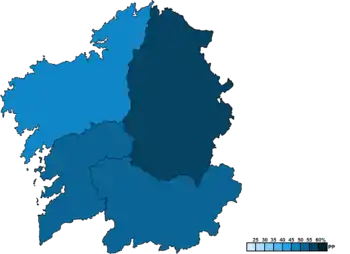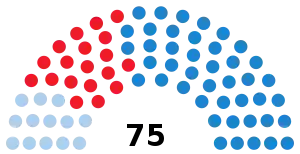1993 Galician regional election
The 1993 Galician regional election was held on Sunday, 17 October 1993, to elect the 4th Parliament of the autonomous community of Galicia. All 75 seats in the Parliament were up for election.
| |||||||||||||||||||||||||||||||||||||||||||||
All 75 seats in the Parliament of Galicia 38 seats needed for a majority | |||||||||||||||||||||||||||||||||||||||||||||
|---|---|---|---|---|---|---|---|---|---|---|---|---|---|---|---|---|---|---|---|---|---|---|---|---|---|---|---|---|---|---|---|---|---|---|---|---|---|---|---|---|---|---|---|---|---|
| Opinion polls | |||||||||||||||||||||||||||||||||||||||||||||
| Registered | 2,293,169 | ||||||||||||||||||||||||||||||||||||||||||||
| Turnout | 1,472,017 (64.2%) | ||||||||||||||||||||||||||||||||||||||||||||
| |||||||||||||||||||||||||||||||||||||||||||||
 Constituency results map for the Parliament of Galicia | |||||||||||||||||||||||||||||||||||||||||||||
| |||||||||||||||||||||||||||||||||||||||||||||
The People's Party (PP) won with an increased absolute majority over 1989, resulting in Manuel Fraga being re-elected for a second term in office as President of Galicia. The Socialists' Party of Galicia (PSdeG–PSOE) suffered from a crisis of leadership and from a desire of punishment to the national government of Felipe González, losing many votes in the way. Meanwhile, the Galician Nationalist Bloc (BNG) began to appear as the main alternative to power thanks to its spokesman, Xosé Manuel Beiras', charisma.
The Galician Unity coalition of United Left (EU) and the Galician Socialist Party–Galician Left (PSG–EG) did not enter Parliament due to a change of the electoral law in 1991, which raised the electoral threshold from 3% to 5%. Galician Coalition (CG) also failed to enter Parliament, and only got 0.4% of the share.
Overview
Electoral system
The Parliament of Galicia was the devolved, unicameral legislature of the autonomous community of Galicia, having legislative power in regional matters as defined by the Spanish Constitution of 1978 and the regional Statute of Autonomy, as well as the ability to vote confidence in or withdraw it from a regional president.[1]
Voting for the Parliament was on the basis of universal suffrage, which comprised all nationals over eighteen, registered in Galicia and in full enjoyment of their political rights. The 75 members of the Parliament of Galicia were elected using the D'Hondt method and a closed list proportional representation, with a threshold of five percent of valid votes—which included blank ballots—being applied in each constituency. Parties not reaching the threshold were not taken into consideration for seat distribution. Seats were allocated to constituencies, corresponding to the provinces of La Coruña, Lugo, Orense and Pontevedra, with each being allocated an initial minimum of 10 seats and the remaining 35 being distributed in proportion to their populations.[1][2]
The use of the D'Hondt method might result in a higher effective threshold, depending on the district magnitude.[3]
Election date
The term of the Parliament of Galicia expired four years after the date of its previous election, unless it was dissolved earlier. The election decree was required to be issued no later than the twenty-fifth day prior to the date of expiry of parliament and published on the following day in the Official Journal of Galicia (DOG), with election day taking place between the fifty-fourth and the sixtieth day from publication. The previous election was held on 17 December 1989, which meant that the legislature's term would have expired on 17 December 1993. The election decree was required to be published in the DOG no later than 23 November 1993, with the election taking place up to the sixtieth day from publication, setting the latest possible election date for the Parliament on Saturday, 22 January 1994.[1][2]
The president had the prerogative to dissolve the Parliament of Galicia and call a snap election, provided that it did not occur before one year had elapsed since a previous dissolution under this procedure. In the event of an investiture process failing to elect a regional president within a two-month period from the first ballot, the Parliament was to be automatically dissolved and a fresh election called.[4]
Parties and candidates
The electoral law allowed for parties and federations registered in the interior ministry, coalitions and groupings of electors to present lists of candidates. Parties and federations intending to form a coalition ahead of an election were required to inform the relevant Electoral Commission within ten days of the election call, whereas groupings of electors needed to secure the signature of at least one percent of the electorate in the constituencies for which they sought election, disallowing electors from signing for more than one list of candidates.[2][5]
Below is a list of the main parties and electoral alliances which contested the election:
| Candidacy | Parties and alliances |
Leading candidate | Ideology | Previous result | Gov. | Ref. | |||
|---|---|---|---|---|---|---|---|---|---|
| Votes (%) | Seats | ||||||||
| PP | List
|
.jpg.webp) |
Manuel Fraga | Conservatism Christian democracy |
44.02% | 38 | |||
| PSdeG– PSOE |
List
|
.jpg.webp) |
Antolín Sánchez | Social democracy | 32.68% | 28 | |||
| BNG | List
|
.jpg.webp) |
Xosé Manuel Beiras | Galician nationalism Left-wing nationalism Socialism |
9.33%[lower-alpha 1] | 5 | |||
| EU–UG | List
|
.jpg.webp) |
Camilo Nogueira | Socialism Communism |
5.27%[lower-alpha 2] | 2 | |||
| CG | List
|
 |
César Quintián Noas | Galician nationalism Liberalism Christian democracy |
3.64% | 2 | |||
Opinion polls
The table below lists voting intention estimates in reverse chronological order, showing the most recent first and using the dates when the survey fieldwork was done, as opposed to the date of publication. Where the fieldwork dates are unknown, the date of publication is given instead. The highest percentage figure in each polling survey is displayed with its background shaded in the leading party's colour. If a tie ensues, this is applied to the figures with the highest percentages. The "Lead" column on the right shows the percentage-point difference between the parties with the highest percentages in a given poll. When available, seat projections are also displayed below the voting estimates in a smaller font. 38 seats were required for an absolute majority in the Parliament of Galicia.
| Polling firm/Commissioner | Fieldwork date | Sample size | Turnout | BNG | CG | Lead | ||||
|---|---|---|---|---|---|---|---|---|---|---|
| 1993 regional election | 17 Oct 1993 | N/A | 64.2 | 52.1 43 |
23.7 19 |
18.4 13 |
[lower-alpha 3] | 0.4 0 |
3.0 0 |
28.4 |
| Demoscopia/El País[p 1][p 2] | 10 Oct 1993 | 2,500 | 66 | 51.9 43 |
25.5 19/21 |
15.4 11 |
[lower-alpha 3] | – | 3.8 0/2 |
26.4 |
| ICP–Research/Diario 16[p 3][p 4][p 5] | 10 Oct 1993 | ? | 61.9 | 47.0 39/43 |
27.8 22/24 |
13.3 9/10 |
[lower-alpha 3] | – | ? 0/2 |
19.2 |
| Sigma Dos/El Mundo[p 3][p 4] | 10 Oct 1993 | ? | ? | ? 39 |
? 24 |
? 11 |
[lower-alpha 3] | – | ? 1 |
? |
| Eco Consulting/Faro de Vigo[p 3][p 4][p 5] | 10 Oct 1993 | ? | ? | ? 40/42 |
? 20/22 |
? 11/12 |
[lower-alpha 3] | – | ? 2 |
? |
| Ecom 6/El Correo Gallego[p 3][p 4][p 5] | 10 Oct 1993 | ? | ? | ? 38/41 |
? 21/25 |
? 10/12 |
[lower-alpha 3] | – | ? 0/2 |
? |
| Gallup/La Voz de Galicia[p 4] | 10 Oct 1993 | ? | ? | ? 40/43 |
? 22 |
? 9 |
[lower-alpha 3] | – | ? 2/3 |
? |
| Sondaxe/La Voz de Galicia[p 6] | 3 Oct 1993 | ? | ? | 51.0 40 |
24.1 20/21 |
16.5 12 |
[lower-alpha 3] | – | ? 1/2 |
26.9 |
| PP[p 6] | 3 Oct 1993 | 1,800 | ? | ? 38/42 |
? 22/24 |
? 10/12 |
[lower-alpha 3] | – | ? 0/1 |
? |
| ABC[p 7] | 17 Sep 1993 | ? | ? | ? 38 |
? 23 |
? 13 |
[lower-alpha 3] | – | ? 1 |
? |
| 1993 general election | 6 Jun 1993 | N/A | 69.6 | 47.1 38 |
36.0 29 |
8.0 6 |
[lower-alpha 3] | 0.3 0 |
4.7 2 |
11.1 |
| 1991 local elections | 26 May 1991 | N/A | 62.5 | 40.4 | 31.5 | 7.7 | 2.8 | 3.7 | 1.6 | 8.9 |
| IMOP[p 8] | 18–29 May 1990 | ? | ? | 45.2 | 30.6 | 9.6 | – | – | – | 14.6 |
| 1989 regional election | 17 Dec 1989 | N/A | 59.5 | 44.0 38 |
32.7 28 |
8.0 5 |
3.8 2 |
3.6 2 |
1.5 0 |
11.3 |
Results
Overall
 | |||||||||||
| Parties and coalitions | Popular vote | Seats | |||||||||
|---|---|---|---|---|---|---|---|---|---|---|---|
| Votes | % | ±pp | Total | +/− | |||||||
| People's Party (PP) | 763,839 | 52.14 | +8.12 | 43 | +5 | ||||||
| Socialists' Party of Galicia (PSdeG–PSOE) | 346,831 | 23.68 | –9.00 | 19 | –9 | ||||||
| Galician Nationalist Bloc (BNG)1 | 269,233 | 18.38 | +9.05 | 13 | +8 | ||||||
| United Left–Galician Unity (EU–UG)2 | 44,902 | 3.07 | –2.20 | 0 | –2 | ||||||
| Galician Coalition (CG) | 6,098 | 0.42 | –3.22 | 0 | –2 | ||||||
| Ruiz-Mateos Group–European Democratic Alliance (ARM–ADE) | 5,293 | 0.36 | –0.17 | 0 | ±0 | ||||||
| The Greens of Galicia (Os Verdes) | 4,682 | 0.32 | +0.08 | 0 | ±0 | ||||||
| Galician Alternative (AG) | 3,187 | 0.22 | New | 0 | ±0 | ||||||
| The Ecologists (LE) | 2,987 | 0.20 | –0.01 | 0 | ±0 | ||||||
| Humanist Citizen Platform (PCH) | 2,508 | 0.17 | +0.11 | 0 | ±0 | ||||||
| United People's Assembly (APU) | 1,492 | 0.10 | New | 0 | ±0 | ||||||
| Coalition for a New Socialist Party (NPS)3 | 503 | 0.03 | ±0.00 | 0 | ±0 | ||||||
| Blank ballots | 13,355 | 0.91 | +0.51 | ||||||||
| Total | 1,464,910 | 75 | ±0 | ||||||||
| Valid votes | 1,464,910 | 99.52 | +0.34 | ||||||||
| Invalid votes | 7,107 | 0.48 | –0.34 | ||||||||
| Votes cast / turnout | 1,472,017 | 64.19 | +4.69 | ||||||||
| Abstentions | 821,152 | 35.81 | –4.69 | ||||||||
| Registered voters | 2,293,169 | ||||||||||
| Sources[6][7] | |||||||||||
Aftermath
| Investiture Manuel Fraga (PP) | ||
| Ballot → | 1 December 1993 | |
|---|---|---|
| Required majority → | 38 out of 75 | |
Yes
|
43 / 75 | |
32 / 75 | ||
| Abstentions | 0 / 75 | |
| Absentees | 0 / 75 | |
| Sources[6] | ||
Notes
- Results for Galician Nationalist Bloc (7.97%, 5 seats) and Galician Nationalist Party–Galicianist Party (1.36%, 0 seats) in the 1989 election.
- Results for Galician Socialist Party–Galician Left (3.78%, 2 seats) and United Left (1.49%, 0 seats) in the 1989 election.
- Within EU–UG.
References
- Opinion poll sources
- "Los socialistas ceden entre 7 y 9 escaños". El País (in Spanish). 10 October 1993.
- "Fraga refuerza su mayoría absoluta". El País (in Spanish). 10 October 1993.
- "Elecciones de 17 de octubre de 1993 al Parlamento Gallego". Revista de Derecho Político (in Spanish). 1995.
- "Fraga: "La verdadera encuesta es la que sale de las urnas. No hay que confiarse"". ABC (in Spanish). 12 October 1993.
- "Todos los sondeos amplían la mayoría absoluta para Fraga y dan un descenso del PSOE". La Vanguardia (in Spanish). 11 October 1993.
- "Los sondeos pronostican una nueva mayoría absoluta del PP y el descalabro del PSOE". ABC (in Spanish). 3 October 1993.
- "Claves de siete días". ABC (in Spanish). 18 September 1993.
- "El "caso Naseiro" y las "listas negras" no deterioraron la imagen de Fraga en la Xunta". ABC Sevilla (in Spanish). 17 June 1990.
- Other
- "Ley Orgánica 1/1981, de 6 de abril, de Estatuto de Autonomía para Galicia". Organic Law No. 1 of 6 April 1981. Boletín Oficial del Estado (in Spanish). Retrieved 8 August 2017.
- "Ley 8/1985, de 13 de agosto, de elecciones al Parlamento de Galicia". Law No. 2 of 13 August 1985. Boletín Oficial del Estado (in Spanish). Retrieved 8 August 2017.
- Gallagher, Michael (30 July 2012). "Effective threshold in electoral systems". Trinity College, Dublin. Archived from the original on 30 July 2017. Retrieved 22 July 2017.
- "Ley 1/1983, de 22 de febrero, de normas reguladoras de la Xunta y su Presidencia". Law No. 1 of 22 February 1983. Boletín Oficial del Estado (in Spanish). Retrieved 8 August 2017.
- "Ley Orgánica 5/1985, de 19 de junio, del Régimen Electoral General". Organic Law No. 5 of 19 June 1985. Boletín Oficial del Estado (in Spanish). Retrieved 28 December 2016.
- "Elecciones al Parlamento de Galicia (1981 - 2020)". Historia Electoral.com (in Spanish). Retrieved 25 September 2017.
- "Parliament of Galicia election results, 17 October 1993" (PDF). www.juntaelectoralcentral.es (in Spanish). Electoral Commission of Galicia. 11 November 1993. Retrieved 25 September 2017.